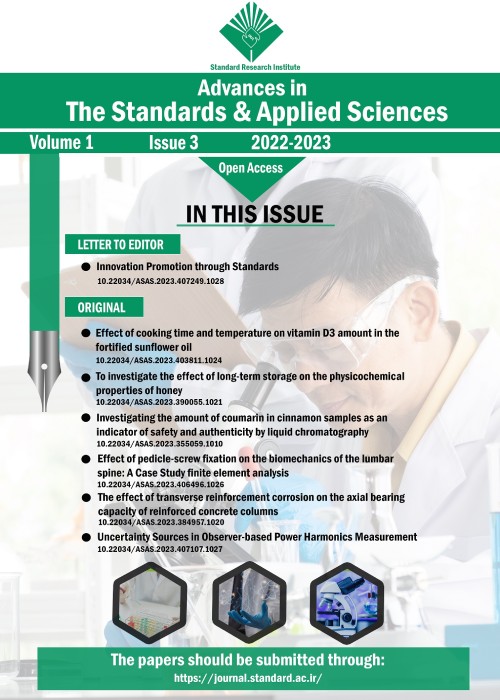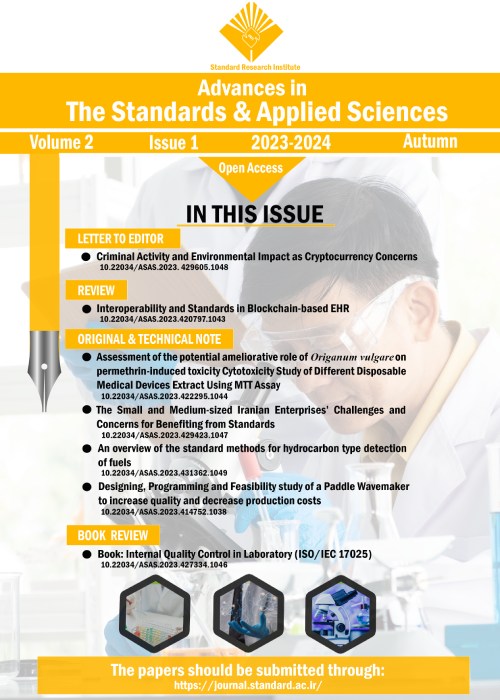فهرست مطالب

Advances in the Standards and Applied Sciences
Volume:1 Issue: 3, Spring 2023
- تاریخ انتشار: 1402/04/10
- تعداد عناوین: 7
-
Pages 1-2
Over the last three decades, there has been some research on the relationship between innovation and standardization [1]. There are, according to the different organizations regarding the type, sector, maturity level, or size, different types of innovations (e.g. product, service, process, model, and method) ranging from incremental to radical, or the different types of approaches (e.g. internal and open innovation, user-, market-, technology- and design-driven innovation activities). Some important questions in these studies are such as: - Is standardization an innovation enabler or an innovation barrier?- How can an organization find and maintain the correct balance between standardization and innovation during times of organizational change?- What is the interrelation between standardization and the concepts of open and responsible innovation?- Are companies active in standardization more successful in winning public procurement contracts?Research has discovered that standardization plays a facilitative role in innovation by enabling scalability, verification, and coordination [2].
Keywords: Standard, Innovation, standardization -
Effect of pedicle-screw fixation on the biomechanics of the lumbar spine: A Case Study finite element analysisPage 2
The pedicle-screw fixation is widely used for the surgical treatment of degenerative lumbar disease. The biomechanical effects of the fusion on the vertebral bodies have not still been investigated in detail. In this study, we intended to calculate the stress and strain of the vertebral bodies and intervertebral discs of the lumbar spine after posterior pedicle-screw fixation (PPSF). A three-dimensional (3D) patient-specific finite element (FE) model of the human L1 to L5 spine was established based on the computed tomography (CT)/magnetic resonance imaging (MRI) images. A preload along with a sinusoidal load, were applied to the proximal end (L1). The distal end (L5) was fixed in all directions. The highest stress and strain were observed in the intervertebral disc of L4-L5 and L1-L2. The stress and strain of the unilateral pedicle-screw were higher than the bilateral ones. The results suggested that the unilateral pedicle-screw provides greater stability comparing to bilateral fixation in posterior bending position. The results have implications not only for understanding the stress and strain of the vertebral bodies and intervertebral discs but also, they give comprehensive information to the biomechanical and medical experts concerning the stability of the spine in the posterior bending position.
Keywords: Pedicle-screw fixation, Lumbar spine, Posterior fixation, Von Mises Stress, Finite element analys -
Pages 3-10
According to WHO report, more than 2 billion people in the world suffer from micronutrient deficiencies caused largely by a dietary deficiency of vitamins and minerals. Fortification of some staple foods is one of the simplest and most practical methods to combat micronutrient deficiencies for both poor and wealthy societies. In this study sunflower oil was fortified with different concentrations (0.1, 0.3, 0.9, 1 and 10 μg/mL) of vitamin D3. Then the reduction of vitamin D3 for concentrations of 0.1 and 0.9 μg/mL at different times (0, 2, 4, and 6h) and cooking temperatures (70, 110, and 150○C) and also at deep-fat frying temperature of 180○C, concentrations of 1 and 10 μg/mL were investigated.The results showed that the relative resistance of this vitamin observed at 70 ○C. Over the specified time, at 110, and 150 ○C, the amounts of vitamin D3 were decreased significantly. At 180 °C (deep frying), more than 60% of vitamin D3 was decomposed. Also, after heating, pyro- and iso-pyrocalciferol were detected as vitamin D3 decomposition compounds at deep-fat frying temperature using GC-MS. Based on the obtained results, free- vitamin D3 added to cooking oil can be stable at temperature lower than 100○C but for higher temperature, encapsulation of it is proposed.
Keywords: Oil, Fortification, Pyrocolecalciferol, Isopyrocolecalciferol -
Pages 11-18
The freshness of food is of great importance to the consumer. To investigate the effect of long-term storage on the physicochemical properties of honey, 6 polyfloral samples were stored at ambient temperature for 12 months and their chemical properties including, hydroxymethylfurfural, diastase number, sugar content (glucose, fructose, and sucrose), and proline were determined periodically (3 month interval). The hydroxymethylfurfural and sugars content were determined by high performance liquid chromatography. Results showed that dramatic changes were observed after 9 and 12 months storage in the chemical and biochemical characteristics of honey samples. The average values of determined specifications of 6 honey samples after 12 months were as follows: hydroxymethylfurfural 74.2±0.1 to 753.5±1.2 mg/kg, diastase 3.2±0.5 to 18.1±0.2, Proline 219.3±1.6 to 507.0±2.2 mg/kg, glucose from 15.6±1.2 to 25.4±1.2 (%), fructose 18.3±1.7 to 27.6±1.3 (%), and sucrose 0.4±0.3 to 4.2±0.5 (%). The current study revealed that hydroxymethylfurfural values in all of the samples were higher than standard limit after one year storage. Although sugars, proline, and diastase showed a wide range of variation in entire polyfloral honey samples during long-term storage, some of them were still in accordance with the standard range recommended by the Codex Alimentarius. Therefore these specifications cannot be used to determine the freshness of honey since: 1) their initial levels in honey samples are very different (depends on the type of honey and other factors), 2) their changing behavior during storage is not consistent; which make them unreliable parameters for determining the freshness of polyfloral honey.
Keywords: honey, Diastase number, Proline, Sugars, Hydroxymethylfurfural -
Pages 19-27
Cinnamon is one of the world's oldest, important and commonly used spices in food industries. Since cinnamon has different varieties which they have diffident qualities, therefore, development of methods for characterization of different variates and evaluation of quality of cinnamon sample is very important. In this research a simple, fast and sensitive method based on liquid chromatography for determination of coumarin as authenticity and safety index in cinnamon samples has been developed. first, several factors influencing the extraction efficiency of coumarin including composition of extraction solvent and type of sample agitation were studied and optimized. Under the optimal conditions, good linear behavior over the investigated concentration ranges (0.2-500 mg/L) with good correlation of determination, R2> 0.996 were obtained. The relative standard deviations (RSDs) based on six replicate determinations at 100 mg/L level of coumarin was less than 6 percent. In studied samples concentration of coumarin was obtained in the range of 6.1-227.7 mg kg-1. Also, between color and coumarin amount of the samples there is positive significant correlation and samples with dark brown color have higher levels of coumarin
Keywords: Authenticity, Cinnamon, Coumarin, High performance liquid chromatography -
Pages 34-41
In recent years, damage to reinforced concrete structures due to chloride corrosion has become a growing problem for the durability of structures, which reduces the capacity and the service life of reinforced concrete structures, as well as reducing safety. Therefore, a model and reliable method for assessing the remaining resistance is necessary. This method, by evaluating the structure, can help to optimize the maintenance and increase the service life of reinforced concrete structures in corrosive environments. Confined transverse reinforcements play important roles in improving the strength and ductility of reinforced concrete columns so that this fact is mentioned in most design codes. Chloride corrosion of such reinforcements has seriously become a growing challenge for the durability of structures leading to reductions in the capacity of reinforced concrete structures and their lifetime. Because the transverse reinforcements have small concrete covers and close to free surfaces, the corrosion in these rebars occurs earlier and more severe than longitudinal reinforcements. Reductions in confinement, deformation capacity, and ductility of reinforced concrete structures are the major consequences of corrosion. Therefore, the main objective of this article is to investigate different reinforced concrete columns under diverse corrosion levels. Based on the results, the reduction in the strength of the circular columns reinforced by the spirals is larger than the corresponding rate in the rectangular columns confined by the stirrups. These cases indicate that the spirals are more sensitive to corrosion than the stirrups.
Keywords: Reinforced Concrete Columns, Transverse reinforcement, corrosion, Confinement -
Pages 42-47
Power harmonics, inter-harmonics and sub-harmonics are among the most challenging issues in power quality and electromagnetic compatibility. Harmonics are known to cause overheating of transformers, increased transmission losses and inadvertent operation of remote relays. Accurate and fast measurement or estimation of harmonics amplitude and phases is an important task for conformity assessment of electrical devices, harmonics mitigation, issuance of electricity bills for industrial sector and many other purposes. Harmonic measurement techniques are diverse and numerous. One of the most common approaches is to use state observers or Kalman filters to measure harmonics. In this paper, different uncertainty sources in observer-based harmonic measurement techniques are discussed. Two common approaches, namely; methods based on the Fourier transform and observer-based approaches are discussed in this regard. Identification and quantification of these uncertainty sources is of vital importance in laboratory accreditation according to ISO/ IEC 17025 standard for quality management in testing laboratories. After each source of uncertainty is identified, it should be quantified using either of the two existing evaluation methods.
Keywords: electromagnetic compatibility, power harmonics, harmonic distortion, Measurement uncertainty


